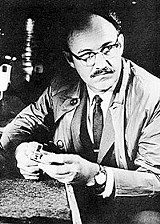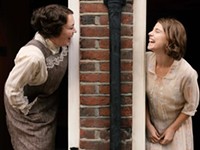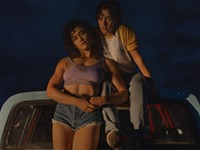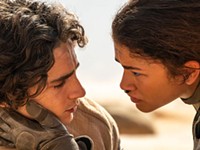[
{
"name": "500x250 Ad",
"insertPoint": "5",
"component": "15667920",
"parentWrapperClass": "",
"requiredCountToDisplay": "1"
}
]
By now you've probably seen that new The Shining trailer making the rounds on the Internet. Someone's put a different spin on the Kubrick horror classic by reassembling a few snippets from the film and mixing them with drippy pop and a saccharine voiceover.
Instead of Jack Nicholson playing a man who terrorizes his family as he becomes unhinged, we get Jack Nicholson as a goofy blocked writer who befriends a boy seeking a father figure. It's good for a few yuks. It's also a decent testament to the power of editing.
Special effects still grab lots of attention, but the real "movie magic" happens in the cutting room --- where a bunch of music and footage is put together to, hopefully, tell a story and make you feel something. When it's technically sound, good editing tends to go largely unnoticed. And that's what makes Walter Murch such an interesting case.
Murch, who's worked as film/sound editor for Apocalypse Now, The Conversation, American Graffiti, every Godfather, and, most recently, the Gulf War drama Jarhead, has an oddly high profile. Along with Scorsese fave Thelma Schoonmaker, Murch is cinema's most well known contemporary editor. That still hasn't made him a household name. But his work has landed him three Oscars (two for The English Patient, one for Apocalypse Now) and plenty of visibility.
Cursory Google searches will score you any number of Murch's academic essays (our favorite's the one where he compares the color spectrum to the sound spectrum) and technical profiles (Murch edited Jarhead using Final Cut Pro, thank you very much). Then there's his appearance as the main subject in one of film's most revered contemporary texts: The English Patient writer Michael Ondaatje's 2002 collection, The Conversations: Walter Murch and the Art of Editing Film. It's quite a lot of attention for a career spent mashing up bits of filmed "reality."
"Nothing in our biological evolution has ever prepared us for something like this," Murch says of the cut, his primary editing tool. "It's really amazing. Here's this whole visual reality that is completely convincing, and in an instant we're going to take it away and replace it with something else. And people accept it. Even more amazingly, you can make people feel something without making them sick to their stomachs."
City Newspaper spoke with Murch to preview his November 19 visit to the Dryden Theatre at the George Eastman House. He'll be in town to present The Conversation and, on November 20, Return to Oz (the one film he actually directed), as part of the Dryden series "The Discreet Art of Sound Design."
When it comes to sound, Murch's history is fascinating. His involvement in Apocalypse Now found him arranging --- for the first time in film's history --- all the movie's sound for Dolby 5.1 stereo surround.
"I remember adding the opening sound of Apocalypse Now late in the process," Murch says. "We had the sound of this sort-of 'ghost' helicopter flying around the room. You know, just the blades: a whupwhupwhup sound. My original plan was simply to have it come out of center speaker and have the film reveal its potential over time. At the last minute I thought: Nope, I'm gonna have the helicopter pan around the room.
"I'm gonna start in the dark and have the sound start in the right rear corner and then move to left rear corner, then to the right front corner, and then have it move across the screen," he says. "It was kind of like a shot across the bow. 'We're gonna be doing this in this film.' Right in the beginning, you're forcing the audience to think about sound. Then, of course, you have a film like The Conversation, which is about a sound recordist. So sound plays a crucial role in the story. It's told from the point of view of the soundman Harry Caul, the Gene Hackman character. He's listening to the world, so you listen to the world."
Ironically, sound is one of the last things Murch thinks about when he begins editing. It's Murch's long-time practice to turn the sound off when compiling his first assembly edits, making himself "willfully deaf" to achieve a greater intimacy with the visual material. "Like deaf people, you become very alert to subtle cues and body language. Then there's this added plus: When I think a scene is up and on its feet, I'll turn the sound on and there will be a whole mixture of things, some of which will be happy accidents, like overlapping dialogue. I'll preserve what works, and then I'll fix the things that need to be fixed."
So much of what he does is attuning his brain to the "language" of whatever film he's working on. "The better the film is, the more unique the language. But no one knows what that language is before you start out. What are its rhythms? What does it think is real? What is not real? What is acceptable? I immerse myself in the same way you would if you went to a foreign country."
It's all uncharted territory. But Murch has come to revel in the impossibility of it all.
"The dominant feeling I have whenever I start a project is, 'I don't know how to edit this film. I can't do this,'" he says. "That's because I don't know the language. But once you get into it, you start to pick up on a few words."
Walter Murch presents The Conversation (Francis Ford Coppola, 1974) on Saturday, November 19, at the Dryden Theatre, George Eastman House, 900 East Avenue, at 8 p.m. He'll show his own Return to Oz on Sunday, November 20, in the Dryden at 8 p.m. $6, $5 students, $4 members. 271-4090, www.eastmanhouse.org.
Walter's world
We asked Murch to list a few films he'd recommend to folks interested in editing (aside from the movies he's worked on). He came up with a list after issuing the following disclaimer:
"These are some of the films that got me interested in editing, but this was me back in the '50s and '60s. These were films being made at the time, so now they're historical films. But you can learn from them."
• Breathless (Jean-Luc Godard, 1960)
• The Seventh Seal (Ingmar Bergman, 1957)
• Seven Samurai (Akira Kurosawa, 1954)
• The 400 Blows (François Truffaut, 1959)
• Yojimbo (Akira Kurosawa, 1961)
Latest in Movie Reviews
More by Chad Oliveiri
-
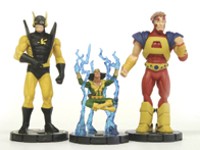
Fiz - 1.11.06
Jan 11, 2006 -
It’s the economy, stupid
Jul 27, 2005 -

Like a larger-than-life music box
Jun 22, 2005 - More »
